Authentic German Lebkuchen
This post may contain affiliate links. See my disclosure policy.
Dating back to the 14th century in Nuremberg, Germany, Elisenlebkuchen have stood the test of time as one of Germany’s most popular and beloved of all Christmas treats. And having eaten more Lebkuchen in my life than I care to admit, I can promise you that absolutely nothing beats homemade. You’ll fall in love with this authentic German Lebkuchen recipe, made after traditional Nürnberger fashion.

Having grown up in Germany it’s the Christmas season when I get the most homesick. The snowy landscapes, the decorations, the Christmas markets, and all the delicious Christmas goodies…you just can’t beat Christmas in Germany. One of Germany’s most famous Christmas treats (and one of my personal favorites), is Elisenlebkuchen, and that’s the German Lebkuchen recipe I’m sharing today.
What is Lebkuchen?
Lebkuchen go all the way back to 14th century Germany where they were created by Catholic monks. Prepared in monastery bakeries, Lebkuchen included honey, a variety of spices and nuts. These ingredients not only had symbolic religious meaning but were highly prized for their healing properties. Those clever monks not only created an exceptionally delicious sweet treat, they found an additional use for their communion wafers: They increased the diameter size and used them as the base for the sticky gingerbread dough – a perfect solution.
A quintessential sweet treat throughout all of Germany during the Christmas season, Lebkuchen is one of the most popular and beloved of all German holiday confections. There are a variety of German Lebkuchen, each distinguished by slight alterations in ingredients and most especially the amount of nuts used. But the most highly prized of all are the Nürnberger Elisenlebkuchen. The title is a regionally protected one and only Lebkuchen produced in Nürnberg can be sold as such. The distinguishing characteristic of the Elisenlebkuchen is that they use no flour and have a very high ratio of nuts, specifically a combination of almonds and hazelnuts.

Lebkuchen Key Ingredients
Beyond the basic ingredients of nuts, sugar, eggs, etc, there are three key ingredients that you need to make Lebkuchen. Let’s take a closer look at them:
What are Backoblaten?
An essential item for Elisenlebkuchen are Backoblaten which are very thin wafers that serve as the base for the Lebkuchen. You can get Backoblaten in three sizes: 90mm, 70mm and 50mm. 50mm is mostly used for smaller items like cookies. You can use either 90mm or 70mm for the Lebkuchen depending on how large you want them. Amazon currently has the 70mm oblaten available. Alternatively, you can also use white communion wafers.
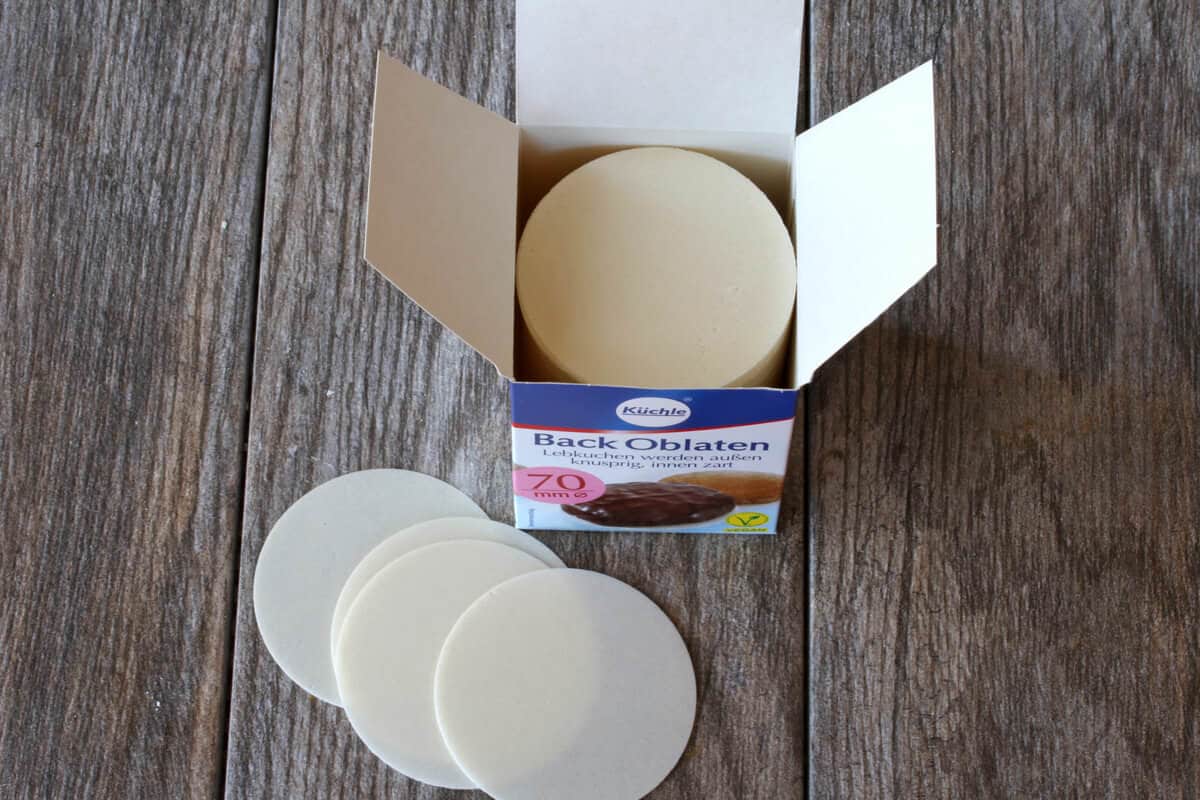
What is Lebkuchengewürz?
An absolutely critical ingredient in these Lebkuchen is Lebkuchengewürz. You cannot make these without Lebkuchengewürz. Period. Not if you want them to taste like real Lebkuchen. And Lebkuchengewürz is virtually impossible to find here in the U.S. unless you’re lucky enough to have a well-stocked German grocery store near you. But have no fear because I’ve got you covered!
Here is my recipe for homemade Lebkuchengewürz, an absolutely magical blend of spices. And even if you find some store-bought Lebkuchengewürz locally or online I still recommend that you make your own because it’s a hundred times better! A richer, deeper, more vibrant flavor. If you add this homemade Lebkuchengewürz to any authentic German recipe calling for Lebkuchengewürz you’ll close your eyes and feel like you’re back in Germany.
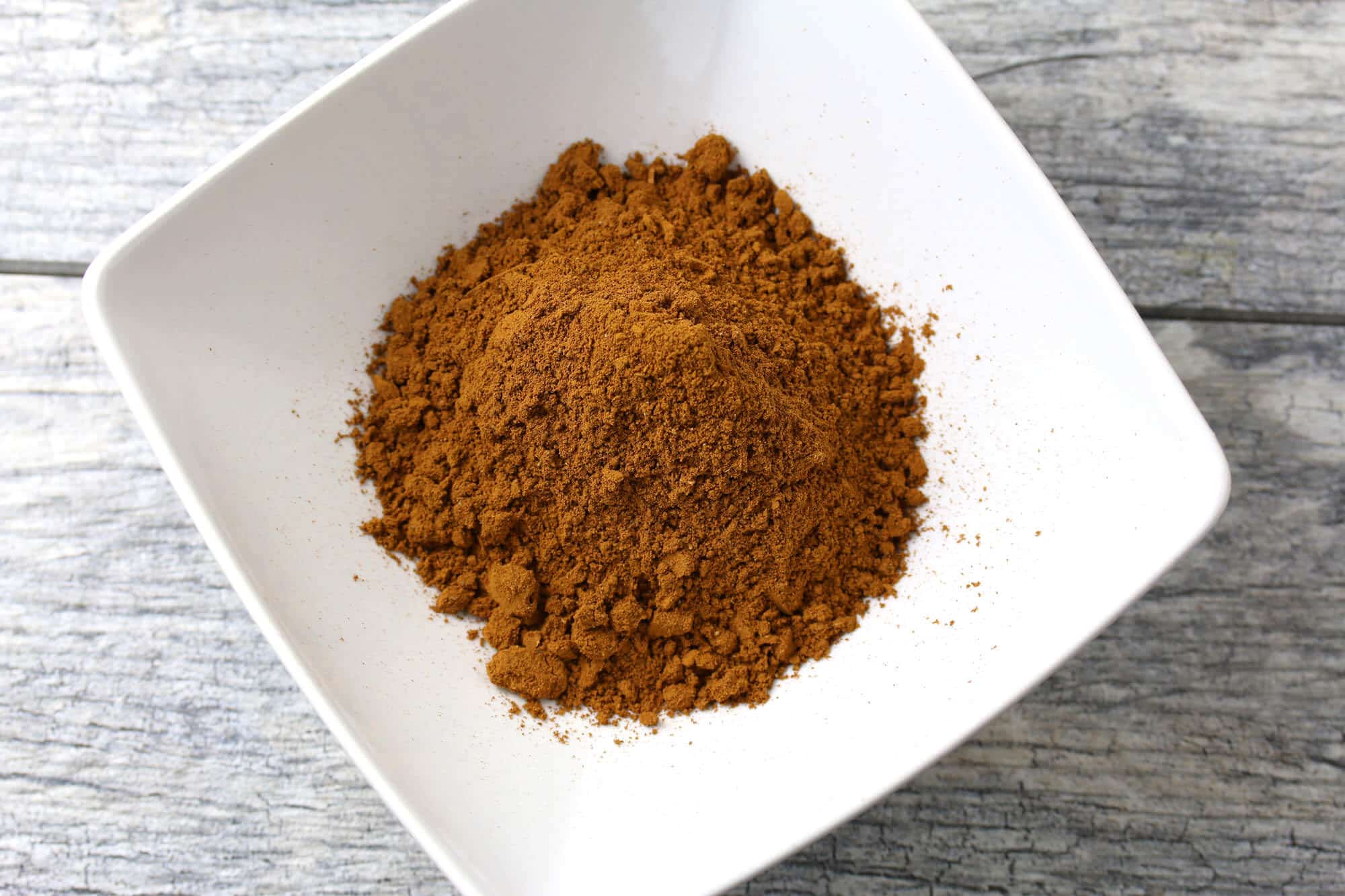
Homemade Candied Citrus Peel
I single this one out as a key ingredient because I emphatically maintain that homemade is essential. Virtually everyone I know detests store-bought citrus peel and I’m in full agreement. The stuff tastes like chemicals. No matter the brand, store-bought candied lemon and orange peel is just super yucky. And it’s a shame because a lot of Christmas baked goods call for candied citrus peel and people buy it because they think they have no other options. But there IS another option. And if you’ve ever put off making things like fruit cakes or German Lebkuchen because you hate that store-bought, chemical-flavored stuff in the plastic container, let me tell you: Homemade candied citrus peel is a 100% deal changer. Not only does it taste good, it tastes amazing and it will make your baked goods taste even more amazing!
Please, please do yourself a favor: Put that store-bought stuff back on the shelf and make some Candied Orange Peel and lemon peel. Your life will change forever!

With these essential ingredients in hand you’re ready to make some seriously amazing homemade Lebkuchen. Growing up in southern Germany I always looked forward to when the Elisenlebkuchen came available. And as good as the store-bought ones are, wait till you try homemade! The texture and flavor of these Elisenlebkuchen is sublime. They keep for a long time and their flavor only gets better the longer they sit and the flavors can ripen. For a truly unforgettable German Christmas pastry, you must give these traditional German Lebkuchen a try!

German Lebkuchen Recipe
Let’s get started!
Be sure to also check out my video in the recipe box. And on a side note, here’s a little trivia for you classical music lovers. I chose Pachelbel’s Canon as the backing track to my video. Can any of you guess what Pachelbel has to do with Nürnberger Elisenlebkuchen? Answer: Pachelbel was from Nürnberg.
You can use a hand mixer or a stand mixer. Place the eggs in a large bowl and beat the eggs until foamy.
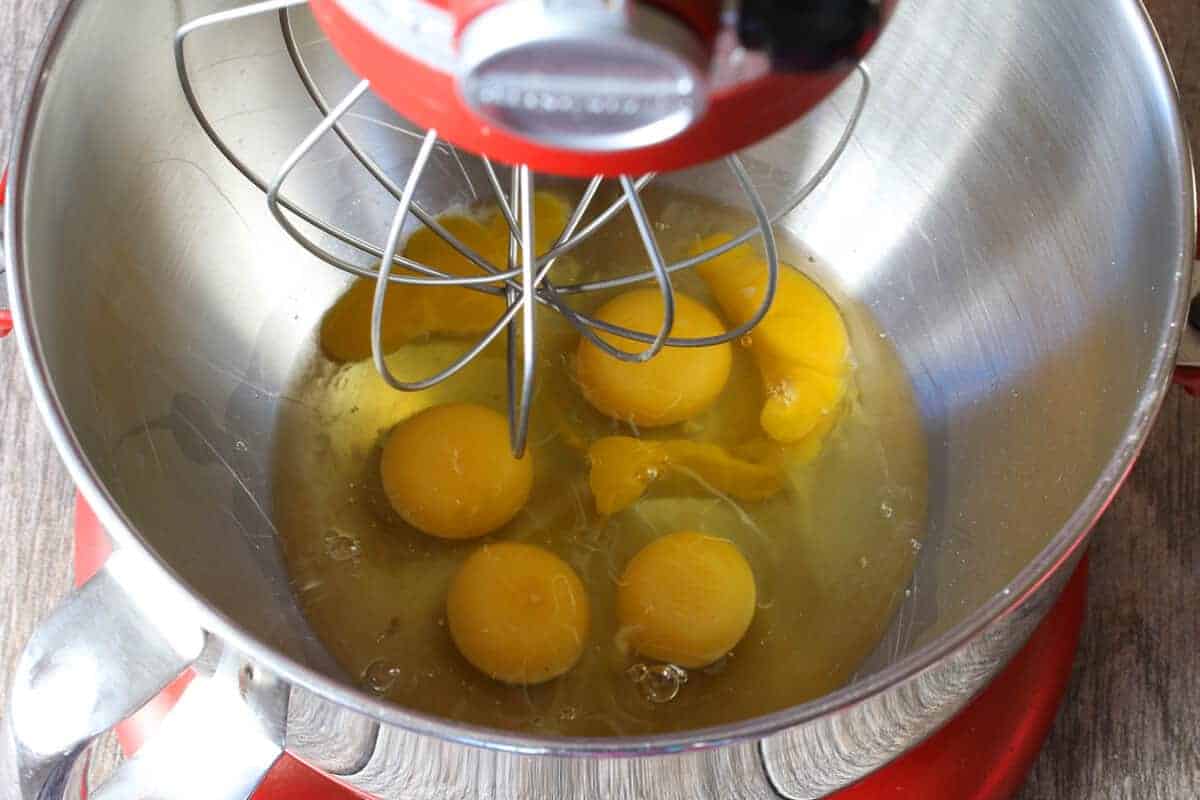
Add the brown sugar, honey and vanilla extract. Beat until combined.
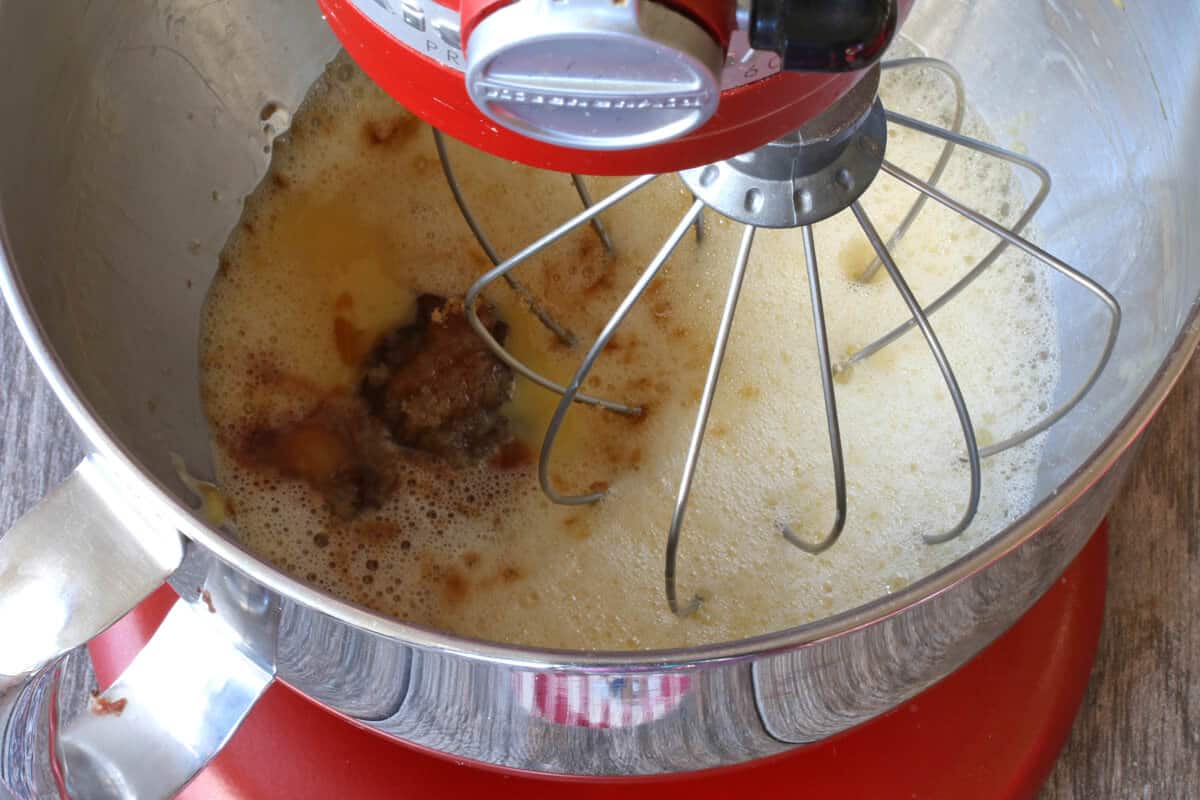
Finely mince the candied lemon and orange peel. The best way to do that is to place them in a bowl and toss them with about 1/4 cup of all-purpose flour to prevent them from sticking together.
Note: If you want truly amazing results, make your own candied citrus peel. The flavor is amazing. It’s super easy to make and once you’ve tried it you’ll never get the store-bought stuff again! Here is my recipe for candied orange peel and lemon peel (same method for both).
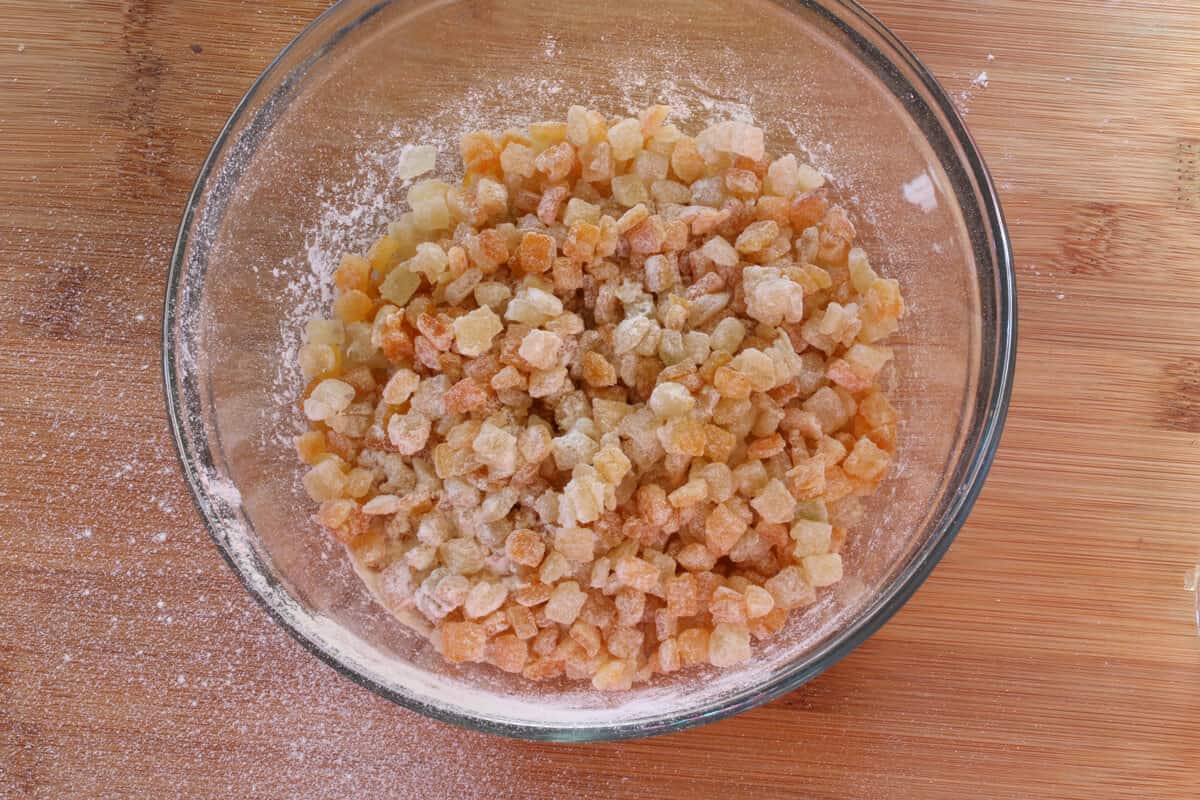
Place it in a food processor and pulse until finely minced.
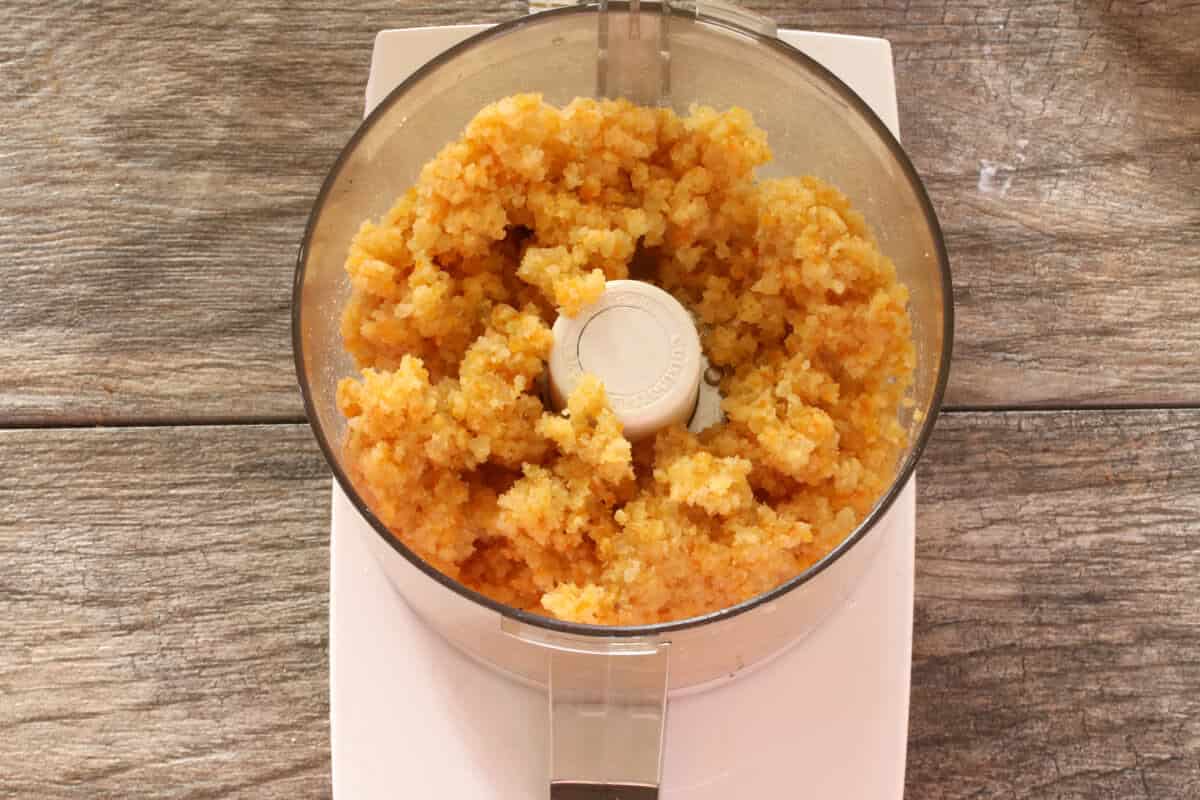
Add the nuts, salt, baking powder, Lebkuchengewürz and candied lemon peel.
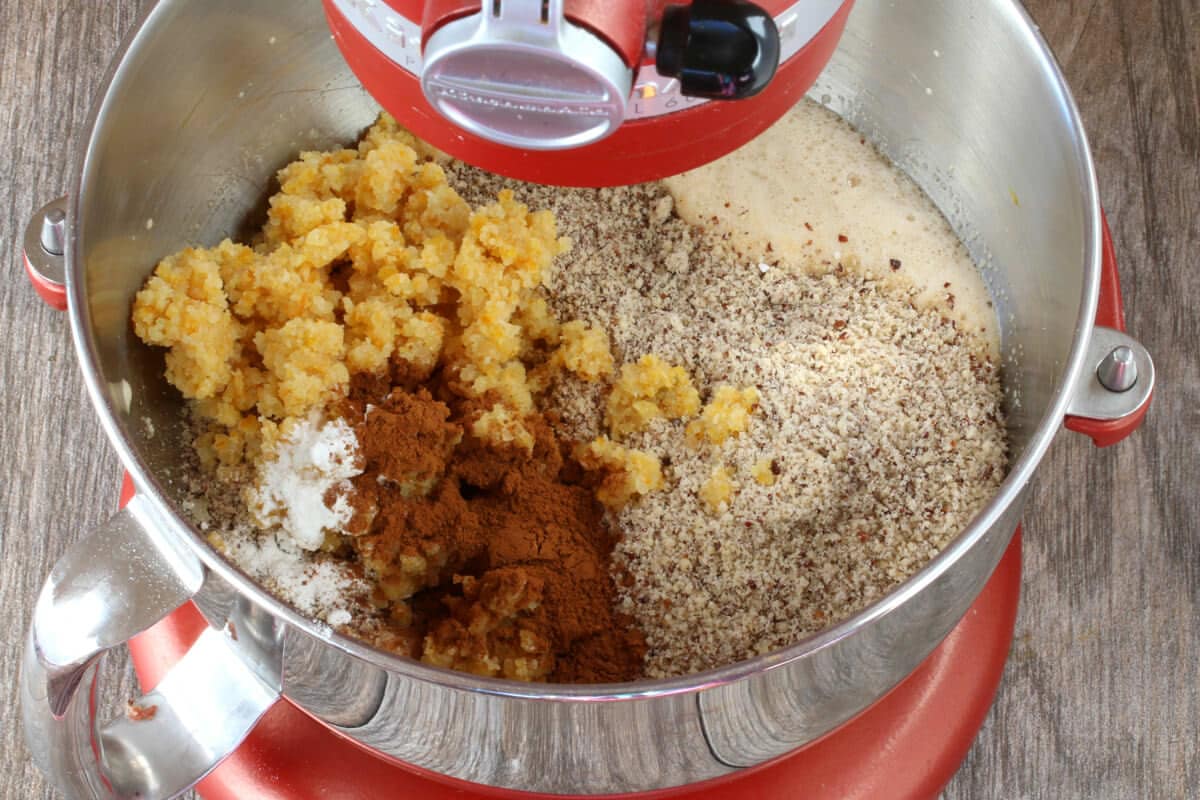
If using a stand mixer, use the paddle attachment and beat on medium for about 2 minutes until thoroughly combined. If you’re not using a stand mixer, beat vigorously with a wooden spoon until thoroughly combined.
The mixture will be wet. If it’s too runny to scoop onto the oblaten add some more almond or hazelnut meal.
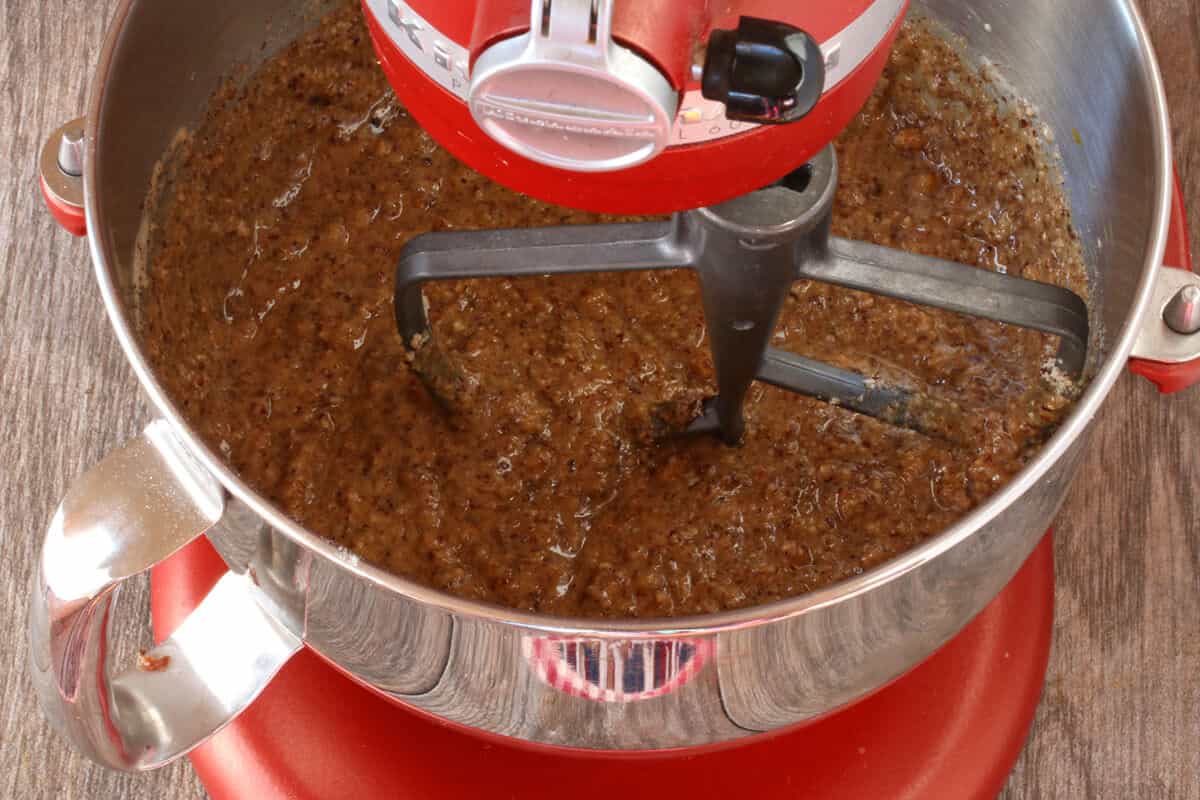
Scoop some of the mixture onto the Backoblaten, smoothing the top and leaving just a tiny bit of an edge around the rim. Place them on a lined cookies sheet.
In an oven preheated to 300 degrees F, bake the Lebkuchen on the middle rack for 25-28 minutes. Remove and let cool completely.
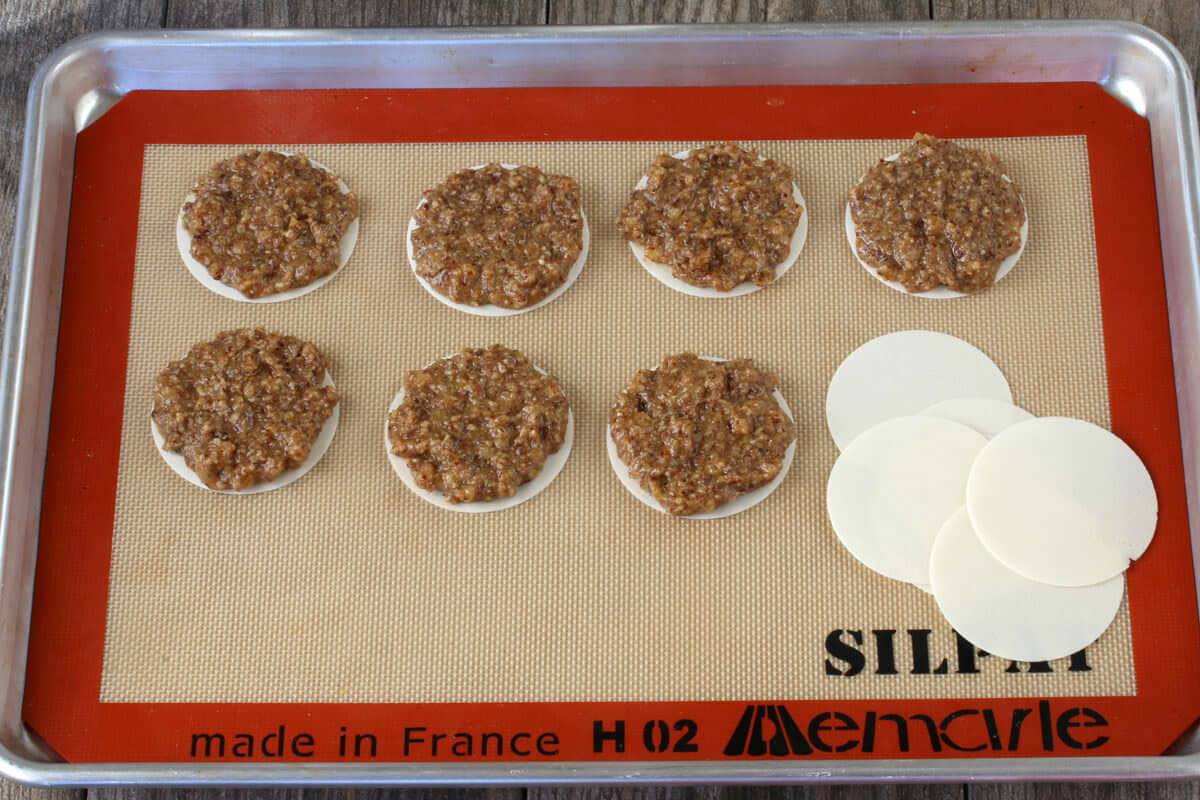
Once the Lebkuchen have cooled, make the glaze. For the chocolate glaze, add the chocolate and oil (I use and love coconut oil for this) and a small bowl and microwave, stirring occasionally, until melted. You’ll want to use it immediately as it will start to firm. If it does firm up simply reheat it for a few seconds in the microwave.
For the sugar glaze, in a small bowl combine the powdered sugar and water and stir until smooth.
Traditionally Lebkuchen are made with these two glazes and some are kept natural (no glaze). Choose whatever you prefer. Chocolate-dipped Lebkuchen have always been my favorite.
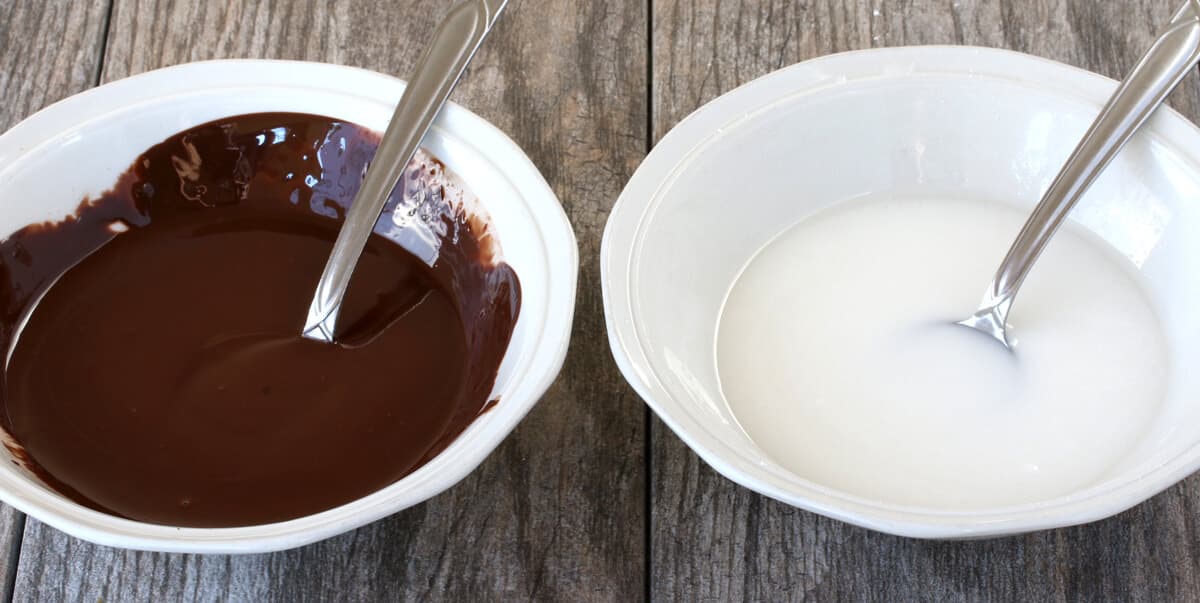
Position a wire rack over a cookie sheet to catch the drippings.
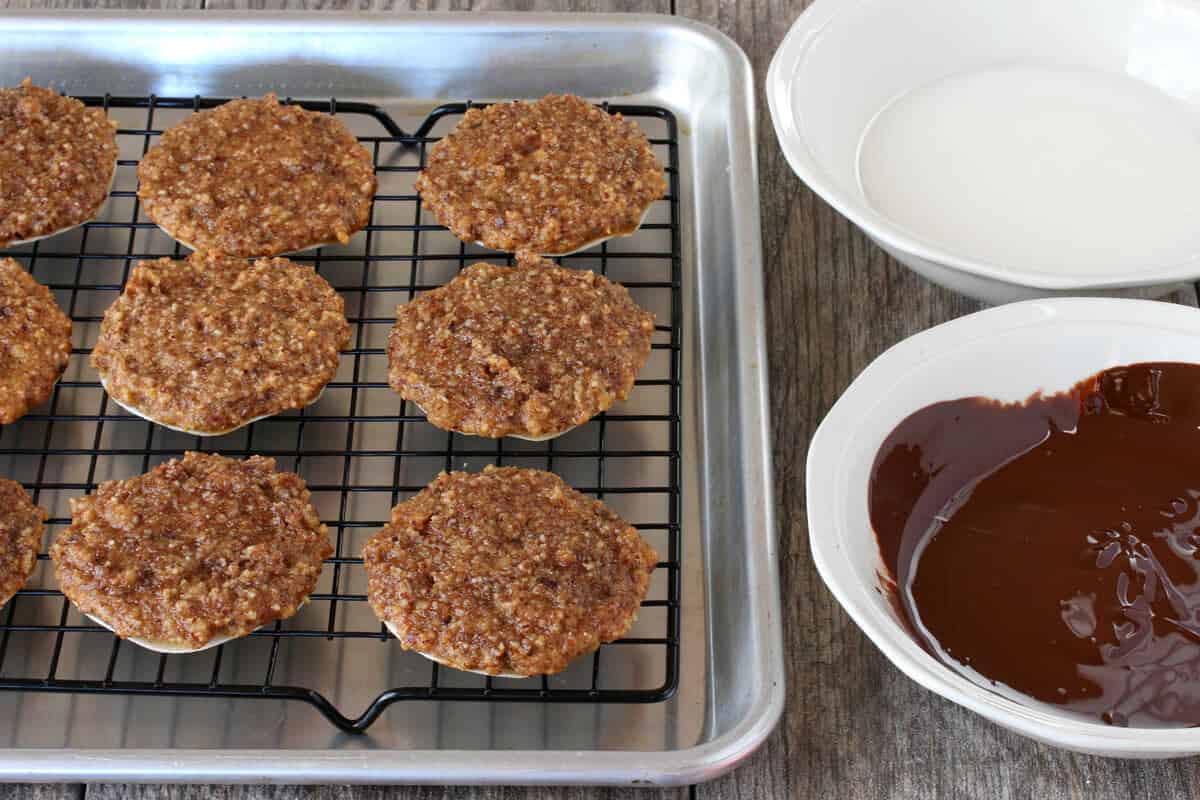
Dip the Lebkuchen into the glazes, letting the excess drip off and placing them on the wire rack to set. Place three blanched almond halves on each Lebkuchen while the glaze is still wet. Let the Lebkuchen sit undisturbed until the glaze is fully set.
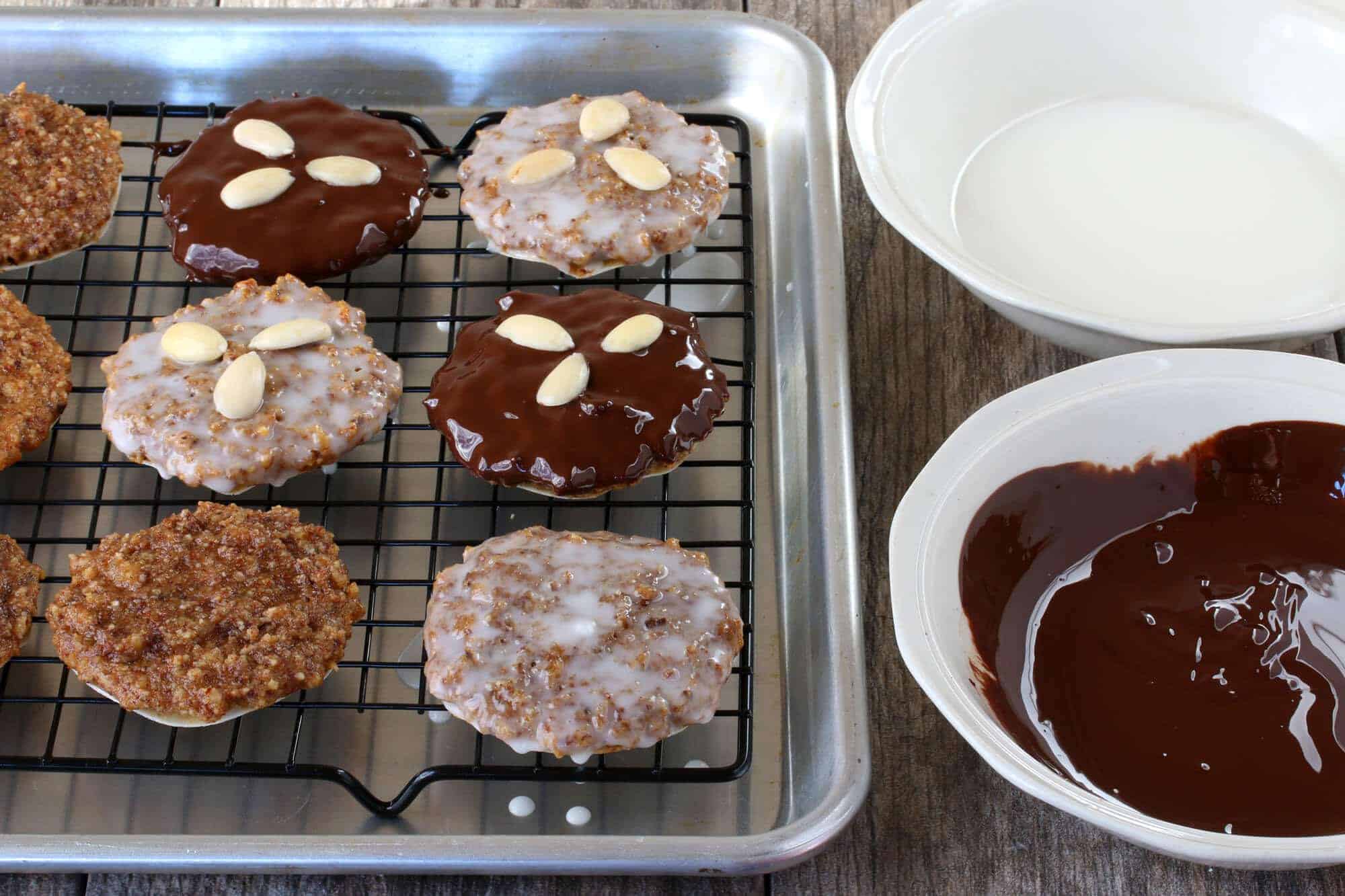
Keep the Lebkuchen stored in an airtight container where they will keep for a few weeks. And their flavor only gets better with time.
Enjoy!
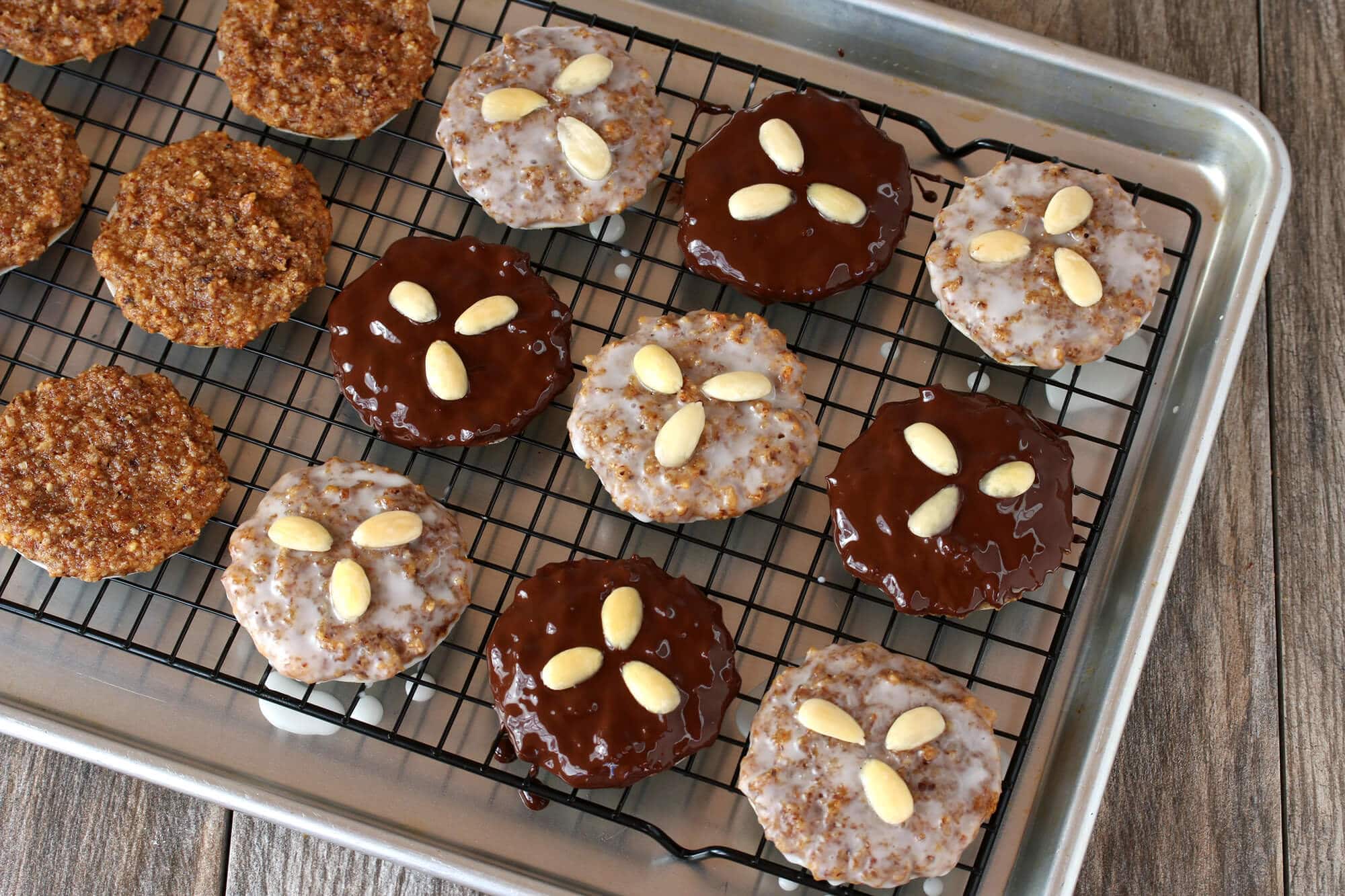
For more delicious and authentic German Christmas recipes try my:
- Stollen
- Pfeffernüsse
- Springerle
- Printen
- Marzipan
- Speculoos
- Vanillekipferl
- Zimtsterne
- Bethmännchen
- Heidesand
- Gugelhupf
- Magenbrot
Save This Recipe

Authentic German Lebkuchen
Equipment
- Backoblaten , either 70mm or 90mm
Ingredients
- 5 large eggs
- 1 1/4 cup packed brown sugar
- 1/4 cup honey
- 1 teaspoon quality pure vanilla extract
- 2 cups almond meal
- 2 cups hazelnut meal
- 1/4 teaspoon salt
- 1/2 teaspoon baking powder
- 3 teaspoons Lebkuchengewürz
- Homemade Lebkuchengewürz , (STRONGLY recommended), click link for recipe
- 4 ounces candied lemon peel
- 4 ounces candied orange peel
- 1/4 cup all-purpose flour (to coat the candied peel) (can substitute gluten free)
- Homemade Lemon and Orange Peel , click link (STRONGLY recommended instead of store-bought!)
- Backoblaten either 70mm or 90mm
- white communion wafers (these can be substituted for Backoblaten)
- Blanched whole almonds cut in half lengthwise
- For the Chocolate Glaze:
- 3 ounces quality dark or milk chocolate
- 2 teaspoons coconut oil or oil of choice – do not use butter
- Directions: Place chocolate and oil in a small bowl and microwave stirring occasionally, until melted. Use immediately. If glaze becomes firm, reheat in the microwave.
- For the Sugar Glaze:
- 1 cup sifted powdered sugar
- 3 tablespoons water or milk (use water for a clear glaze or milk for an opaque glaze; substitute some heavy cream for the milk for an even more opaque/whiter glaze)
- Directions: Place sugar and water in a small bowl and stir until smooth.
Instructions
- Preheat the oven to 300 degrees F.
- Toss the candied lemon and orange peel with about 1/4 cup all-purpose flour to keep it from sticking together and then pulse in a food processor until finely minced. Set aside.
- In a large mixing bowl, beat the eggs until foamy. Add the sugar, honey and vanilla extract and beat until combined.Add the ground almonds and hazelnuts, salt, baking powder, Lebkuchengewürz, and candied lemon and orange peels and stir vigorously until thoroughly combined. (You can use a stand mixer fitted with the paddle attachment and beat for about 2 minutes). The mixture will be wet but if it is too thin to scoop onto the oblaten add some more almond or hazelnut meal.
- Scoop the mixture onto the Backoblaten, smoothing down the top and leaving just a slight space around the edges. Set them on a lined cookie sheet.Bake on the middle rack of the oven for 25-30 minutes. Remove the cookie sheet and allow to cool completely.
- Once cooled, place a wire rack over a cookie sheet (to catch the drippings). Dip half the Lebkuchen in the chocolate glaze and half in the sugar glaze, letting the excess drip back into the bowl and then place the Lebkuchen on the wire rack. Arrange 3 almonds on each Lebkuchen while the glaze is still wet. Let the Lebkuchen dry completely until the glaze is hardened.Keep stored in an airtight container. Will keep for several weeks and the flavor improves with time.Makes about 35 if using 70mm Backoblaten and about 25 if using 90mm Backoblaten.
Video
Nutrition
Originally published on The Daring Gourmet December 16, 2015



















I do not see the amount of hazelnuts and almonds needed. I do see the almonds cut in half.
How much hazel nut and ground almonds do I use. I don’t want to make this until I have all the ingredients.
Hopefully, I will get am answer soon.
Thanks
Jeanine
Hi Jeanine, they’re the 5th and 6th ingredients in the ingredient list – you’ll need 2 cups of almond meal and 2 cups of hazelnut meal. Happy baking and I hope you enjoy them!
Beyond delicious! While in Germany before the holidays I ate my weight in gluten-free lebkuchen from seven different vendors. This recipe is as good or better than any of those! I brought Backoblaten, the candied orange and lemon peel as well as the whole spices (couldn’t find mace there or here) home from Germany. The first time I followed the recipe exactly – fantastic! The second time I made a few tweaks. I made my own candied lemon and orange peel, increased the spices by 1/2, decreased the sugar by three tablespoons and pulsed the peel less leaving it a bit chunkier. They turned out crazy delicious! So much better than the first batch which was shocking!Absolutely phenomenal! Thank you for the recipe! Lastly, one bakery in Germany used mini muffin papers instead of backoblaten which I will try when mine are gone.
Oh! I’m so in love with the spice mixture I added a bit to ‘puppy chow’ along with some chopped orange and lemon peel. The next time I make brownies I’m going to add a couple of teaspoons to that too! This is my new favorite spice blend!
I’m so thrilled to hear that, T, thank you very much for the detailed feedback, I appreciate it! Happy New Year!
Found the glaze recipe, thank you,
The Lebkuchen is delicious.
Love my candied citrus rind.
Thanks for the tip to make it myself.
I’m so glad, Renate, thank you very much! <3
Hello,
I plan to make the Lebkuchen and Pfeffernusse recipes as written, but wonder if you have experimented with the following three alternatives:
1. Modified for treenut and peanut allergies – a couple sub-categories:
A. Non-tree seeds: I encountered another confection recipe using sunflower seeds, but those seem more savory than sweet to me. Sesame seeds come to mind, but paired with what? Or maybe just by themselves?
B. Flour combinations: With all the commercially available flours today, it seems some combination might work. Non-treenut seed-based flours would be fine.
2. Modified pairings for flavor, e.g., especially pairing any two of pistachios, pinenuts, black walnuts, regular walnuts, pecans, almonds, or hazelnuts?
3. Single-nut instead of paired – any of the above including almond or hazelnut alone?
Thank you in advance for your help.
Hi Bob, I have not tried the modifications in #1. But for #2, yes you can substitute different nut flours for some flavor variations and likewise for #3 you can use only one kind of nut if you prefer.
This is my third year making these and it will continue to be a beloved tradition. I grew up getting packages of store-bought lebkuchen and chocolates from family in Germany and always looked forward to that. These are even better than the store-bought and I love giving them as gifts. I have made my own candied citrus peel and lebkuchen spice as you direct here, too, and it all comes together beautifully.
I’m so glad, Carly, thank you so very much! <3
I make this once a year for Christmas. I just double the nut meals so the batter doesn’t run off the oblaten, and I use zero AP flour by chopping the peels instead of processing. They’re delightful. I started trying chocolate glaze and am running across an interesting issue: this recipe’s glaze doesn’t appear to call for tempering the chocolate, which I’d need to do since I mail these to family. But when I tried tempered chocolate, the lebkuchen got very dry. (I make them 3 months in advance to age and have never had issues with the sugar glaze). I am wondering if there’s a way to retain moisture with chocolate glaze. Just thought I’d put the question out there. Thanks again for the great recipe! My whole family looks forward to them.
Beautiful recipe, have made it for several years now. Thank you. My adjustments are as follows: Half the amount of sugar, double the amount of Lebkuchengewürz, and a simple version of candied citrus peel: soak the dried organic peel pieces in hot water, or a sugar solution (I use 1:4 solution for convenience, same concentration as for hummingbird nectar :-) until rehydrated, drain, toss in flour and chop up in the food processor as per recipe instructions. May require some extra nut meal if the dough is too wet. Absolute treat. I double the recipe, and often have to make another batch, a lovely Christmas gift.
Thank you so much for the feedback, Monika, I’m thrilled this has become your go-to the last several years! <3
How thick should the cookies be if you don’t use the backoblaten? As in, should you press the dough down or just scoop it out into balls?